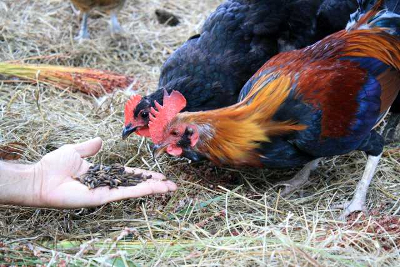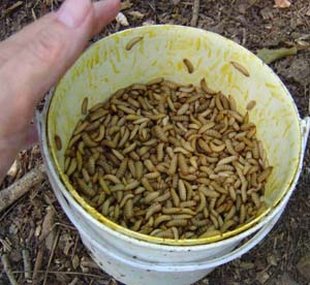
Black soldier fly larvae for compost and chicken feed
 As I've explained previously,
black
soldier flies are primarily grown to provide high quality animal feed, although they can also be
considered a way to get rid of food scraps. The larvae are
voracious feeders that can consume huge amounts of high nitrogen waste
without any input of high carbon components. Since you don't have
to add bedding, the bins can be much
smaller than a worm bin while consuming the same amount of food
waste. Even better, the larvae self-harvest, crawling right into
a collection bucket so that you can feed them to your chickens,
lizards, fish, or other critters.
As I've explained previously,
black
soldier flies are primarily grown to provide high quality animal feed, although they can also be
considered a way to get rid of food scraps. The larvae are
voracious feeders that can consume huge amounts of high nitrogen waste
without any input of high carbon components. Since you don't have
to add bedding, the bins can be much
smaller than a worm bin while consuming the same amount of food
waste. Even better, the larvae self-harvest, crawling right into
a collection bucket so that you can feed them to your chickens,
lizards, fish, or other critters.
If you add 100 pounds of
food waste to your black soldier fly bin, you should end up with 20
pounds of prepupae (large larvae, ready to change into adults.) A
nutritional analysis of dried black soldier fly prepupae consists of:
- 42.1% crude protein
- 34.8% ether extract (lipids)
- 7.0% crude fiber
- 7.9% moisture
- 1.4% nitrogen free extract (NFE)
- 14.6% ash
- 5.0% calcium
- 1.5% phosphorus
 Take a look at your bag of
chicken laying pellets, and you'll probably notice some
similarities. If you fed your chickens a quarter of their daily
rations in the form of black soldier flies, you could take care of most
of their protein and calcium needs, then round out their diet with
cheap components like greens and grains. In addition to saving
money, folks growing black soldier flies for their chickens report that
the feed makes their hens' eggs brilliantly orange, a sign of high
nutrition.
Take a look at your bag of
chicken laying pellets, and you'll probably notice some
similarities. If you fed your chickens a quarter of their daily
rations in the form of black soldier flies, you could take care of most
of their protein and calcium needs, then round out their diet with
cheap components like greens and grains. In addition to saving
money, folks growing black soldier flies for their chickens report that
the feed makes their hens' eggs brilliantly orange, a sign of high
nutrition.
Larvae are the primary
output of the black soldier fly bin, but you do get a bit of compost
--- about 5 pounds for every 100 pounds of food waste you put in the
bin. This small amount of compost can be good for city-dwellers
who don't have room to use up a lot of compost anyway and who would be
thrilled not to have to clean out their food composter for months at a
time. On the other hand, if you're primarily composting your food
scraps to add fertility to the garden, black soldier flies probably
aren't the way to go.
The other disadvantage
of black soldier flies compared to worm bins or compost piles is that
black soldier fly bins are relatively high maintenance. Since you
don't add high carbon bedding to absorb odors, you have to pay
attention and only add as much food to your bin as your larvae will eat
in a day. However, if you're running a diversified homestead and
have a bunch of chickens, that bit of time is probably worth it for the
high quality feed you get in exchange. I think that compost
piles, worm bins, and black soldier fly bins will all find a niche on
our farm.
| This post is part of our Black Soldier Fly lunchtime series.
Read all of the entries: |
Want more in-depth information? Browse through our books.
Or explore more posts by date or by subject.
About us: Anna Hess and Mark Hamilton spent over a decade living self-sufficiently in the mountains of Virginia before moving north to start over from scratch in the foothills of Ohio. They've experimented with permaculture, no-till gardening, trailersteading, home-based microbusinesses and much more, writing about their adventures in both blogs and books.
Want to be notified when new comments are posted on this page? Click on the RSS button after you add a comment to subscribe to the comment feed, or simply check the box beside "email replies to me" while writing your comment.

Thanks for sharing your experiences. I just happened to post in my new blog today about my experience with black soldier flies last year, even before I read your post. Long story, short, I wasn't nearly as successful as you were because it is basically a desert where I live. They didn't even last until the snow started falling in autumn, where they probably wouldn't have lasted much longer.
I haven't tried vermicomposting until a few weeks ago, but the worms look much more promising than the BSF larvae. My next step is to find a good source for composting worms since fishing worms are much too expensive to buy in the quantities that I need for the food waste and garden amendments.
I'm glad to hear some first-hand data. We're still in the planning stages, so don't know if they'll work for us yet. It does sound like if you're outside BSFs normal range, they're probably not worth the expense, but we're hopeful that we'll be able to attract wild flies.
You might be interested in reading about our worm bin project --- http://www.waldeneffect.org/tag/worms/. Surface area is key with worms, so you might want to change to a wider rather than deep bin. Good luck!
(Cross-posted over on your blog just in case you don't check back here!)
I created a soldier fly bin by accident once when I came back from a trip and cleaned all the decaying produce out of the garden. I left the 5 gallon bucket sitting under a tree, forgot about it, and the next thing I knew it was full of writhing 1" long maggots.
At the time, I wasn't impressed... seeing as I had no idea what they were and I didn't own chickens. I was mostly hoping they wouldn't get big enough to eat me alive. I didn't realize how useful they could be until I saw Shawn Jadrnicek's bin next to his chicken coop and tilapia pond.
Anyway, I haven't been reading blogs much right now because I'm crunched for time to get all my spring projects done. Came over here to look for photos of you two before the Organic Growers School so it will be easier to find you... and then I got wrapped up in reading lots of the posts. I love your blog!